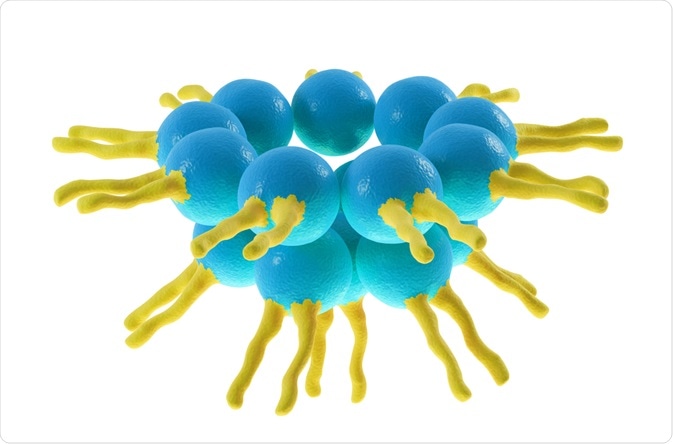Formed from the aggregation of abiotic components, protocells are the precursors to modern living cells. Despite being non-living, protocells display characteristics akin to biological cells.
 Image Credit: Tomasz Swierczynsk / Shutterstock.com
Image Credit: Tomasz Swierczynsk / Shutterstock.com
Understanding the origins of life on earth
The origin of life on Earth is a relatively poorly understood area of science. Complex organic molecules arose from the “primordial soup” which would eventually make possible the abundant variety of organisms, tissues, cellular structures, and biological processes that exist today.
One structure, the cell, is a constant across all biological systems. However, the process of how the cell evolved from a complex mix of organic molecules and organized itself into a distinct structure is not widely known but is subject to research by scientists across the world who are looking to provide these answers.
The cell
Biological cells generally have three features:
- A stable and semi-permeable membrane which encapsulates cell components
- Genetic material which can be passed on in cell formation and which controls cellular behavior and function
- Energy generation via metabolic pathways which enables growth, self-maintenance, and reproduction
Though the complexity and arrangement of organelles and cellular compartments differ, all cells share one feature: the cell membrane. Cell membranes are made of two lipids that ostensibly face each other. The lipids are formed of two parts: A hydrophilic head and a hydrophobic tail. When presented with an aqueous solution, lipid bilayers naturally form a sphere, with the head pointing outward and the tail inward, away from the solution. All of the cell structures are contained within the bilayer.
However, the question remains: what led to the evolution of the cell? One theory that has been postulated to explain this is that of the protocell.
What are protocells?
Protocells are structures that are formed from the aggregation of abiotic (non-living) components. Despite this, they display certain characteristics akin to living cells. Protocells are basically self-organized, endogenously ordered, spherical collection of lipids.
The first structure to arise in the prebiotic world that could be termed a protocell was the coacervate. This is a spherical membraneless microdroplet that can spontaneously arise from weak organic solutions. Coacervates are held together by hydrophobic forces and are analogous to the formation of oil droplets in water.
As mentioned, protocells display certain characteristics in common with cells. However, they would have had to achieve these functions in different, simpler manners. In the case of membrane transport, modern cells use complex protein machinery. Protocells may have achieved membrane transport (which is crucial for the exchange of content) passively via processes such as osmosis. In this way, they could have exchanged ions and small molecules with their surrounding environment.
As their membranes were semi-permeable, nucleosides could have been exchanged amongst other things. Information exchange, one of the prerequisites for life, would have been relatively easy between one protocell and another. Vesicle budding could have been another mechanism that could lead to molecular and genetic exchange.
Protocells are thought to have facilitated the reproduction of RNA and therefore the exchange of genetic information at a time before the advent of DNA and proteins (the RNA world hypothesis.) As it is assumed that RNA would have been in too low a concentration to be able to exchange information on their own, they would have needed compartments to replicate in. Protocells would have provided that environment and kick-started the process of life.
Theories on the origin of protocells
There are a few different theories on the emergence of microdroplets which led to protocell formation in the early Earth. Though they differ in their assumptions, they all share one common factor: that protocells were a simple structure that spontaneously arose and acted as a vehicle for the evolution of life on Earth
One such study in 1975 by W.D.Snyder and Sidney W.Fox showed that microdroplets could have arisen in a primitive alkaline ocean. A mixture of 18 proteinous amino acids was heated in a dry state with seawater salts, producing a copolyamino acid. Upon dissolving the seawater proteinoid in boiling water and then cooling the resultant mixture, proteinoid microspheres resulted. Thus, a simple model for the origin of a protocell which was stable in a primitive alkaline ocean was produced.
Another study suggests that primitive cells could have formed inside microcompartments contained in inorganic clay. Montmorillonite clay particles which collected on the outside of air bubbles and forming clay-armored bubbles would have formed the ideal container for structures that led to the formation of the first protocells.
One property of montmorillonite is that it serves as a chemical catalyst for the formation of lipid membranes and RNA. It is possible that primitive reproduction was facilitated when the bubbles burst and the membrane-bound structures were released into the surrounding medium.
Protocells: Both the past and the future of biology
Protocells provide an explanation for how life emerged from the prebiotic world based on current experimental observations of spontaneous phenomena. Whilst there are gaps in our knowledge of early life on Earth, we are managing to home in on the answers. Recent studies have also been carried out to produce stable protocells in the lab, which could be used for such purposes as targeted drug delivery to targets such as tumors.
A Protocell Forming from Fatty Acids
Further Reading